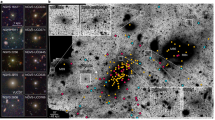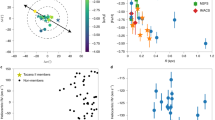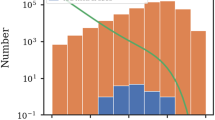Abstract
We present the first attempt at measuring the production rate of tidal dwarf galaxies (TDGs) and estimating their contribution to the overall dwarf population. Using HST/ACS deep imaging data from GOODS and GEMS surveys in conjunction with photometric redshifts from COMBO-17 survey, we performed a morphological analysis for a sample of merging/interacting galaxies in the Extended Chandra Deep Field South and identified tidal dwarf candidates in the rest-frame optical bands. We estimated a production rate about 1.4×10−5 per Gyr per comoving volume for long-lived TDGs with stellar mass 3×108−9 M⊙ at 0.5<z<1.1. Together with galaxy merger rates and TDG survival rate from the literature, our results suggest that only a marginal fraction (less than 10%) of dwarf galaxies in the local universe could be tidally-originated. TDGs in our sample are on average bluer than their host galaxies in the optical. Stellar population modelling of optical to near-infrared spectral energy distributions (SEDs) for two TDGs favors a burst component with age 400/200 Myr and stellar mass 40%/26% of the total, indicating that a young stellar population newly formed in TDGs. This is consistent with the episodic star formation histories found for nearby TDGs.
Similar content being viewed by others
References
Aaronson, M.: Astrophys. J. Lett. 266, L11 (1983)
Abraham, R., et al.: Mon. Not. R. Astron. Soc. 279, L47 (1996)
Barnes, J.E., Hernquist, L.: Nature 360, 715 (1992)
Bell, E.F., de Jong, R.S.: Astrophys. J. 550, 212 (2001)
Bell, E.F., et al.: Astrophys. J. Suppl. Ser. 149, 289 (2003)
Bell, E.F., et al.: Astrophys. J. 640, 241 (2006)
Bernardi, M., et al.: Mon. Not. R. Astron. Soc. 404, 2087 (2010)
Boquien, M., et al.: Astron. J. 140, 2124 (2010)
Bournaud, F., Duc, P.-A.: Astron. Astrophys. 456, 481 (2006)
Bournaud, F., et al.: Astron. Astrophys. 486, 741 (2008)
Bournaud, F., et al.: Astrophys. J. 730, 4 (2011)
Bower, R.G., et al.: Mon. Not. R. Astron. Soc. 370, 645 (2006)
Braine, J., et al.: Astron. Astrophys. 378, 51 (2001)
Bruzual, G., Charlot, S.: Mon. Not. R. Astron. Soc. 344, 1000 (2003)
Ceverino, D., Dekel, A., Bournaud, F.: Mon. Not. R. Astron. Soc. 404, 2151 (2010)
Chabrier, G.: Publ. Astron. Soc. Pac. 115, 763 (2003)
Conselice, C.J.: Astrophys. J. Suppl. Ser. 147, 1 (2003)
Conselice, C.J.: Astrophys. J. 638, 686 (2006)
Conselice, C.J., et al.: Astron. J. 126, 1183 (2003)
Daddi, E., et al.: Astrophys. J. 713, 686 (2010)
Dekel, A., et al.: Nature 457, 451 (2009)
Duc, P.-A., et al.: Astron. Astrophys. 326, 537 (1997)
Duc, P.-A., et al.: Astron. J. 120, 1238 (2000)
Duc, P.-A., et al.: Astron. Astrophys. 427, 803 (2004)
Duc, P.-A., et al.: Astron. Astrophys. 475, 187 (2007)
Eisenstein, D.J., et al.: Astrophys. J. 633, 560 (2005)
Elmegreen, B.G., Elmegreen, D.M.: Astrophys. J. 627, 632 (2005)
Elmegreen, B.G., Kaufman, M., Thomasson, M.: Astrophys. J. 412, 90 (1993)
Elmegreen, D.M., Elmegreen, B.G., Hirst, A.C.: Astrophys. J. Lett. 604, 21 (2004)
Elmegreen, D.M., et al.: Astrophys. J. 663, 734 (2007a)
Elmegreen, D.M., et al.: Astrophys. J. 658, 763 (2007b)
Elmegreen, B.G., et al.: Astrophys. J. 692, 12 (2009)
Förster Schreiber, N.M., et al.: Astrophys. J. 645, 1062 (2006)
Geha, M., et al.: Astrophys. J. 692, 1464 (2009)
Genel, S., et al.: Astrophys. J. 688, 789 (2008)
Genzel, R., et al.: Nature 442, 786 (2006)
Genzel, R., et al.: Astrophys. J. 687, 59 (2008)
Giavalisco, M., et al.: Astrophys. J. Lett. 600, L93 (2004)
Groenewegen, M.A.T., et al.: Astron. Astrophys. 392, 741 (2002)
Hammer, F., et al.: Astrophys. J. 550, 570 (2001)
Hickson, P.: Astrophys. J. 255, 382 (1982)
Hickson, P., et al.: Astrophys. J. 399, 353 (1992)
Hunsberger, S.D., Charlton, J.C., Zaritsky, D.: Astrophys. J. 462, 50 (1996)
Hunsberger, S.D., Charlton, J.C., Zaritsky, D.: Astrophys. J. 505, 536 (1998)
Jogee, S., et al.: Astrophys. J. 697, 1971 (2009)
Klypin, A., et al.: Astrophys. J. 522, 82 (1999)
Kroupa, P., et al.: Astron. Astrophys. 523, 32 (2010)
Lavery, R.J., et al.: Astrophys. J. 612, 679 (2004)
Lotz, J.M., et al.: Astrophys. J. 636, 592 (2006)
Maller, A.H., et al.: Astrophys. J. 647, 763 (2006)
Marconi, G., et al.: Astron. J. 109, 173 (1995)
Mateo, M., et al.: Astron. J. 105, 510 (1993)
Mendes de Oliveira, C., Hickson, P.: Astrophys. J. 427, 684 (1994)
Mihos, J.C.: Astrophys. J. Lett. 438, L75 (1995)
Moles, M., et al.: Astron. Astrophys. 285, 404 (1994)
Moore, B., et al.: Astrophys. J. Lett. 524, L19 (1999)
Neuschaefer, L.W., et al.: Astrophys. J. 480, 59 (1997)
Okazaki, T., Taniguchi, Y.: Astrophys. J. 543, 149 (2000)
Retzlaff, J., et al.: Astron. Astrophys. 511, A50 (2010)
Rix, H.-W., et al.: Astrophys. J. Suppl. Ser. 152, 163 (2004)
Robaina, A.R., et al.: Astrophys. J. 719, 844 (2010)
Rubin, V.C., et al.: Astrophys. J. Suppl. Ser. 76, 153 (1991)
Sabbi, E., et al.: Astrophys. J. Lett. 676, L113 (2008)
Shapiro, K.L., et al.: Astrophys. J. 682, 231 (2008)
Simon, J.D., Geha, M.: Astrophys. J. 670, 313 (2007)
Somerville, R.S., et al.: Mon. Not. R. Astron. Soc. 391, 481 (2008)
Stark, D.P., et al.: Nature 455, 775 (2008)
Straughn, A.N., et al.: Astrophys. J. 639, 724 (2006)
Tolstoy, E., Hill, V., Tosi, M.: Annu. Rev. Astron. Astrophys. 47, 371 (2009)
Toomre, A., Toomre, J.: Astrophys. J. 178, 623 (1972)
Tremonti, C.A., et al.: Astrophys. J. 613, 898 (2004)
Weilbacher, P.M., et al.: Astron. Astrophys. 358, 819 (2000)
Weilbacher, P.M., Duc, P.-A., Fritze-v Alvensleben, U.: Astron. Astrophys. 397, 545 (2003)
Weisz, D.R., et al.: Astrophys. J. 689, 160 (2008)
Wetzstein, M., Naab, T., Burkert, A.: Mon. Not. R. Astron. Soc. 375, 805 (2007)
Wolf, C., et al.: Astron. Astrophys. 401, 73 (2003)
Wuyts, S., et al.: Astrophys. J. 682, 985 (2008)
Zhang, H.X., Gao, Y., Kong, X.: Mon. Not. R. Astron. Soc. 401, 1839 (2010)
Zepf, S.E., Whitmore, B.C.: Astrophys. J. 418, 72 (1993)
Zepf, S.E., Whitmore, B.C., Levison, H.F.: Astrophys. J. 383, 524 (1991)
Zwicky, F.: Ergeb. Exakten Naturwiss. 29, 344 (1956)
Author information
Authors and Affiliations
Corresponding author
Rights and permissions
About this article
Cite this article
Wen, ZZ., Zheng, XZ., Zhao, YH. et al. Tidal dwarf galaxies at intermediate redshifts. Astrophys Space Sci 337, 729–737 (2012). https://doi.org/10.1007/s10509-011-0882-8
Received:
Accepted:
Published:
Issue Date:
DOI: https://doi.org/10.1007/s10509-011-0882-8




